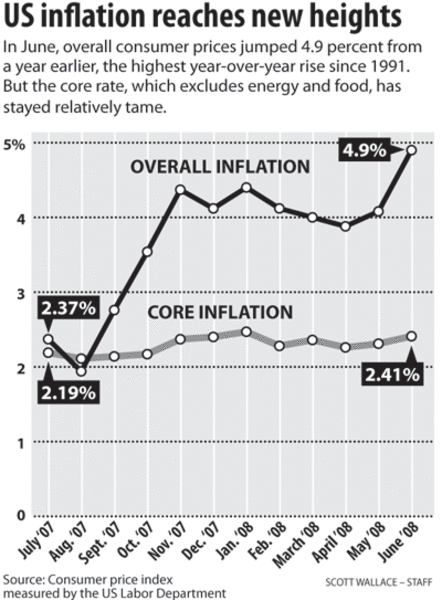Inflation surge puts Fed in a quandary
Loading...
Consumer prices took their biggest upward jump in 17 years last month, a surge that highlights the squeeze on America's standard of living and the difficult policy choices facing the Federal Reserve.
Fed officials are walking a fine line – and at the moment they'd rather not be forced to focus on inflation as their top priority. They're also trying to revive a moribund economy and prevent a crisis in the financial industry from growing more severe.
Even as consumer prices surged 1.1 percent in June alone, some other news this week gives the central bank some leeway to balance those competing goals. Oil prices, which have been the big driver of inflation around the world this year, fell dramatically.
After trading at about $147 per barrel, oil dived below $134 Wednesday morning. The change stems partly from higher-than-expected crude-oil inventories, announced by the Energy Department, and partly on other factors such as signs of economic weakness.
Still, after a two-day drop, it's too early to say that oil prices are at a turning point. And inflation indicators remain higher than the Fed would like.
"It's a major concern," says Michael Cosgrove, who publishes the EconoClast, a market newsletter in Dallas. "What they're hoping is that the commodity prices start to drift lower later this year. If that happens, then that will go a long way toward resolving the inflation issue." US workers and consumers have been squeezed this year by a combination of fast-rising prices and an economy that's barely growing – with the number of jobs actually falling each month.
As of June, consumer prices have risen by 4.9 percent in the past year, the highest 12-month inflation rate since 1991.
"The troubling part was not so much the headline [inflation number]," says Jay Bryson, an economist at Wachovia Corp. in Charlotte, N.C.
While the overall rate is what burdens consumers, the bigger worry for Fed policymakers was a sign that higher oil prices are feeding into a more generalized rise in prices.
The so-called core rate of inflation, with food and energy prices stripped out, rose 0.3 percent for the month. Rising oil prices have been a global phenomenon, driven largely by demand in emerging markets, that the Fed has little control over. But if last month's rise in the core rate persists, it would be a sign of a widening inflation problem, Mr. Bryson says.
"You're looking at a 3.5 percent [annual] core inflation rate, which is way too high for the Fed's liking," he says.
So far, prices for one of the key costs businesses face – labor – show little sign of spiraling out of control.
Because wages aren't rising very fast, that also limits the ability of businesses to pass along price hikes.
But the rising cost of energy has to be paid by someone, and energy-intensive businesses have been raising prices. Consider the automotive industry, now hit by a mix of sagging vehicle sales and rising prices. Automotive News recently found that:
•Polypropylene, a resin commonly used in plastic parts, has gone up in price by 45 percent in 18 months.
•Tire prices are up 20 percent in three months.
•A type of steel used to make bumpers, wheels, and frames has doubled in price since December.
Basically, consumers and businesses alike are adjusting to a new era in which energy costs more. Even with this week's easing, analysts don't foresee a return of cheap oil.
Whether it's a family budget or a business plan, a larger share of expenses now goes for fuel, leaving less for everything else.
Europe now appears to be joining the US in an economic slowdown, with some risk of recession on both continents. Both the Fed and the European Central Bank thus may stay "on hold" for some time and see if inflation pressures ebb due to a slack economy.
Whether formally a recession or not, that will also curb economic growth somewhat in nations such as China, economists say.
"Eventually the emerging market economies will feel the slowdown in the developed economies," Mr. Cosgrove says. But this doesn't mean energy demand in those nations will stop growing, so he sees the fundamental price of oil staying near $100 per barrel.
"At that level there's plenty of incentive to produce oil. And on the demand side there's still ample incentive to use less," he says.
Even if oil prices merely flatten out, that would do much to control the overall inflation rate, according to Fed Chairman Ben Bernanke.
Many economists expect the Fed's next move on interest rates to be upward but that the boost may not begin until some time in 2009. More bad readings in the core inflation rate could change that outlook, but for now the Fed appears focused especially on what it calls the downside risks to economic growth.
In recent days, Fed officials and the US Treasury have had to focus on trouble in financial markets, with investors worried that mortgage-related losses have compromised many banks and other firms. Fannie Mae and Freddie Mac, firms central to the mortgage market, are in "no danger of failing," Mr. Bernanke said Wednesday according to the Associated Press. But he said that "weakness of market confidence is having an effect" on these firms, making it more difficult for them to raise new capital to cover loan losses.
As the Treasury seeks approval from Congress to offer a financial lifeline, the Fed has also been offering to lend money to the firms if needed. Such moves have become central to the Fed's efforts to ease the financial crisis.
"They don't believe they need to cut [interest] rates further at this point," says Bryson, but they may not raise rates soon, either.






